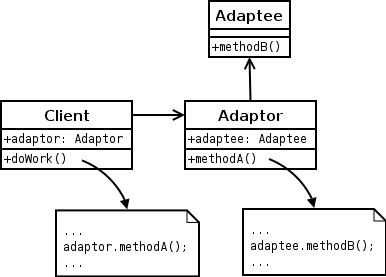 | ||
In software engineering, the adapter pattern is a software design pattern (also known as Wrapper, an alternative naming shared with the Decorator pattern) that allows the interface of an existing class to be used as another interface. It is often used to make existing classes work with others without modifying their source code.
Contents
- Definition
- Usage
- Structure
- Object Adapter pattern
- Class Adapter pattern
- A further form of runtime Adapter pattern
- Implementation of the Adapter pattern
- Crystal
- References
An example is an adapter that converts the interface of a Document Object Model of an XML document into a tree structure that can be displayed.
Definition
An adapter helps two incompatible interfaces to work together. This is the real world definition for an adapter. Interfaces may be incompatible, but the inner functionality should suit the need. The Adapter design pattern allows otherwise incompatible classes to work together by converting the interface of one class into an interface expected by the clients.
Usage
An adapter can be used when the wrapper must respect a particular interface and must support polymorphic behavior. Alternatively, a decorator makes it possible to add or alter behavior of an interface at run-time, and a Facade is used when an easier or simpler interface to an underlying object is desired.
Structure
There are two adapter patterns:
Object Adapter pattern
In this adapter pattern, the adapter contains an instance of the class it wraps. In this situation, the adapter makes calls to the instance of the wrapped object.
Class Adapter pattern
This adapter pattern uses multiple polymorphic interfaces implementing or inheriting both the interface that is expected and the interface that is pre-existing. It is typical for the expected interface to be created as a pure interface class, especially in languages such as Java (before jdk 1.8) that do not support multiple inheritance of classes.
A further form of runtime Adapter pattern
There is a further form of runtime adapter pattern as follows:
It is desired for classA to supply classB with some data, let us suppose some String data. A compile time solution is:
However, suppose that the format of the string data must be varied. A compile time solution is to use inheritance:
and perhaps create the correctly "formatting" object at runtime by means of the Factory pattern.
A solution using "adapters" proceeds as follows:
(i) Define an intermediary "Provider" interface, and write an implementation of that Provider interface that wraps the source of the data, ClassA in this example, and outputs the data formatted as appropriate:
(ii) Write an Adapter class that returns the specific implementation of the Provider:
(iii) Register the Adapter with a global registry, so that the Adapter can be looked up at runtime:
(iv) In code, when wishing to transfer data from ClassA to ClassB, write:
or more concisely:
(v) The advantage can be seen in that, if it is desired to transfer the data in a second format, then look up the different adapter/provider:
(vi) And if it is desired to output the data from ClassA as, say, image data in Class C:
(vii) In this way, the use of adapters and providers allows multiple "views" by ClassB and ClassC into ClassA without having to alter the class hierarchy. In general, it permits a mechanism for arbitrary data flows between objects that can be retrofitted to an existing object hierarchy.
Implementation of the Adapter pattern
When implementing the adapter pattern, for clarity one can apply the class name [ClassName]To[Interface]Adapter to the provider implementation, for example DAOToProviderAdapter. It should have a constructor method with an adaptee class variable as a parameter. This parameter will be passed to an instance member of [ClassName]To[Interface]Adapter. When the clientMethod is called, it will have access to the adaptee instance that allows for accessing the required data of the adaptee and performing operations on that data that generates the desired output.
Crystal
Output
Recharging android with MicroUsb RechargerMicroUsb connectedRecharge startedRecharge finishedRecharging iPhone with MicroUsb using Adapter patternMicroUsb connectedLightning connectedRecharge startedRecharge finishedRecharging iPhone with iPhone RechargerLightning connectedRecharge startedRecharge finished